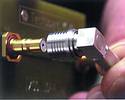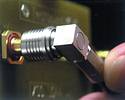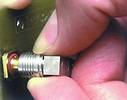
As a result of the growth of the mobile radio market, the time needed for making coaxial connections has become an increasingly important cost factor for basestation manufacturers. A logical consequence of this is to replace threaded connections with snap-on connections offering very good electrical performance. To meet these requirements, Huber + Suhner developed the Suhner QMA coaxial connector.
Today, subminiature SMA connectors are frequently used for establishing the RF connections in the receiving path in basestations. Apart from their many advantages - especially regarding electrical characteristics - these components do have the drawback of requiring a lot of time for making the threaded connection. This stands in the way of an optimised production process.

Simple mating /demating mechanism
In response, Huber + Suhner developed an optimised solution for the frequency range up to 3 GHz commonly encountered in such applications. The time-saving alternative to the SMA - the QMA connector - has a high-quality snap-on mechanism instead of a threaded interface. The mating force is about 25 N. To demate, the cap nut is first pulled backwards. This opens the contact force spring of the outer conductor and allows demating with a force of merely 20 N. If the cap nut is not actuated, a force of more than 60 N is required for disconnection. This high retention force of the connector interface not only produces good vibration resistance and mechanical characteristics, but also excellent electrical values. This straightforward mating and demating operation reduces the time needed for connection or disconnection to about one tenth of the time that a threaded interface required.

No torque spanner
The fact that neither an open-end spanner (wrench) nor a torque spanner is needed for mating the QMA connector produces a large number of benefits: because no space is required for tightening the nut with a spanner, it is possible to increase the packing density. The need for maintenance, calibration, purchasing and storage of a torque spanner is eliminated and there is no danger of aplying an incorrect torque during mating. In addition, the risk is eliminated that a front panel might be scratched.

The sophisticated geometry of the contact force spring produces a butt joint contact, in the same way as with an SMA connector. Thanks to this butt joint contact, it is possible to achieve the same return loss in the frequency range specified for the QMA connector - up to 6 GHz - as with an SMA. The targets specified for the other electrical key characteristics such as passive inter-modulation and RF-leakage are fulfilled, thanks to the design selected. A basic range of QMA connectors is now available. Huber + Suhner has standardised the new interface in cooperation with another well-known connector manufacturer, providing a positive answer to the key question as to a second source.
For further information contact Dartcom, (012) 665 2771.

© Technews Publishing (Pty) Ltd | All Rights Reserved